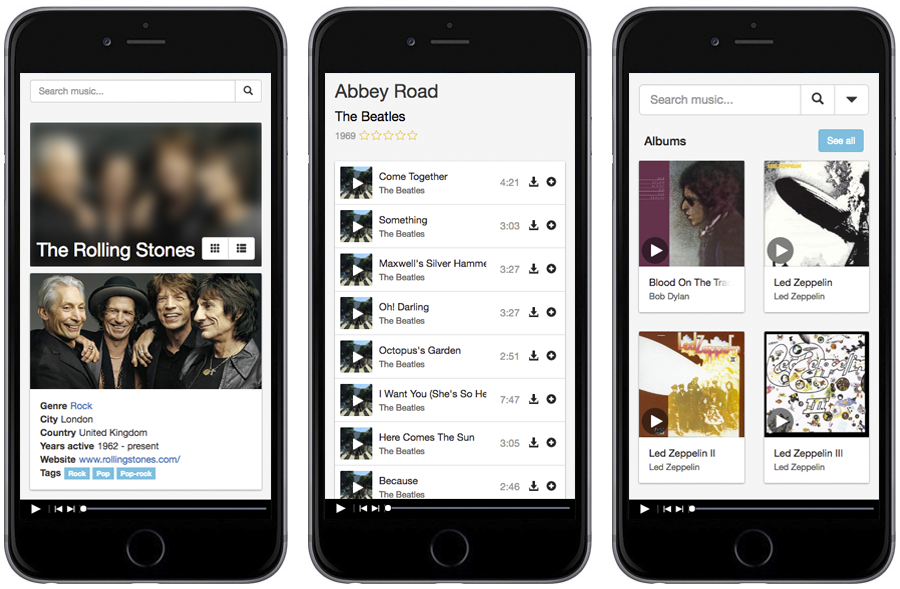

- #Mobile html5 video player download mp4
- #Mobile html5 video player download code
- #Mobile html5 video player download download
The openness of HTML5 video is in service of libraries’ goals. These features are in the works and likely to be implemented by browser vendors, but we may be a ways off from that yet.įor many use cases in libraries and other cultural heritage organizations, DRM and live streaming are not necessary. If you’re looking for live, adaptive streaming, this also won’t currently work for you (See HLS on longtailvideo and HTTP Live Streaming). If there are restrictions on the use of the content or you need digital rights management (DRM), then you will not be able to use HTML5 video at this time ( more on video DRM).
#Mobile html5 video player download download
Right clicking on a video will often show a menu option for “Save Video As….” The browsers seem to prefer to download the type of video it can play, but failing that will download what is there. Any time you use the video element it is simple enough for users to just download the video.

This is the first fork in the road for whether you can publish using HTML5 video. Browsers that do understand the video element will not display this text. To accommodate older browsers having some access to the content you can include some text and a download link like the following. Nothing will show up on the page and the user will not have any access to the video. If you look at the page in an older browser that does not understand the video element, the video will be completely ignored. If it were just that simple then HTML5 video may have taken off a lot sooner and been more ubiquitous by now. The video element cannot be self closing so there is a closing video tag.
#Mobile html5 video player download mp4
This video element has a single src attribute pointing to the relative URL for an MP4 video file.

Note first that the doctype html ensures that the markup will be treated as HTML5, since the video element is new to HTML5. Let’s dive right in and look at the simplest HTML document with a video that will validate. Since video is time-based media, it has many more features–and complications–than an image. This allows you to embed video on a page similar to how you can embed an image with the img element. The HTML5 (or HTML the Living Standard as it is now officially know within the WHATWG) introduced the video element several years ago. Let’s start by taking the video that ought to have shown up on this page and make it work across devices using HTML5 video. We’ll then solve problems as we go along and I’ll provide some background on each solution.
#Mobile html5 video player download code
We’ll start with the simplest code that could possibly work. I’ll also show more advanced uses of Web video as well as some things that are just plain fun. As we go along we’ll make the case for when you might want to consider self-publishing video this way. I won’t go into depth on everything, but will point to the best resources for when you need to dive deeper. This will touch on all the aspects to get you started publishing video on the Web. If you use an iOS (or even a recent Android) device, when you go to view some Web pages with video you’ll sometimes be presented with a page that looks like this:ĭo you have video on your site that is still delivered only through Flash? Are you about to start a project involving video? In this article, I’ll show you what you need to get started with publishing video on the Web so that it will work across browsers and devices. If you see “YKK” anywhere in the text, those are sections I’m still working on and that need to be zipped up. Since I’ve done quite a bit of work and a whole lot of reading, I thought I’d at least publish my incomplete notes. I had originally hoped to publish this in my favorite journal, but I could not complete it in time or find the right hook to differentiate it from all the other writing on the topic out there on the Web. If you read this and something was missing that you really needed, please let me know. I publish it here in the hopes that it might help someone else as well.

Nothing here is particularly original, but gathering it together will at least help me when I have to come back to a video project. Some is incomplete or goes deep into areas that were not important for my projects or what I might want to do. Some of the information that’s out there is outdated. I hope for this to be a gentle introduction to HTML5 Video. This post is in the form of a tutorial where a single page is built up little by little as new problems arise or new features are implemented. As I work on video projects, I will continue to add more and new information to this post. While there is a lot of good information on the Web about HTML5 Video, I wanted to put down everything that I gathered together about it.


 0 kommentar(er)
0 kommentar(er)
